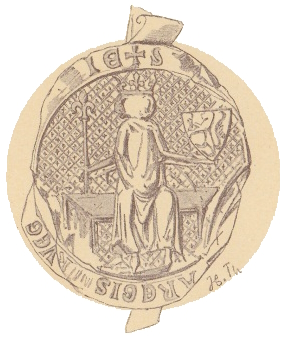Related Research Articles

Haakon VI, also known as Håkan Magnusson, was King of Norway from 1343 until his death and King of Sweden between 1362 and 1364. He is sometimes known as Haakon Magnusson the Younger to distinguish him from his great-grandfather, Haakon V.

Valdemar IV Atterdag, or Waldemar was King of Denmark from 1340 to 1375. He is mostly known for his reunion of Denmark after the bankruptcy and mortgaging of the country to finance wars under previous rulers.

Abel Valdemarsen was Duke of Schleswig from 1232 to 1252 and King of Denmark from 1250 until his death in 1252. He was the son of Valdemar II by his second wife, Berengaria of Portugal, and brother to kings Eric IV and Christopher I.

Christopher II was King of Denmark from 1320 to 1326 and again from 1329 until his death. He was a younger son of Eric V. His name is connected with national disaster, as his rule ended in a near-total dissolution of the Danish state.

Valdemar III (1314–1364) was King of Denmark from 1326 to 1329, while he was underage; he was also Duke of Schleswig as Valdemar V in 1325–26 and from 1330 to 1364. He was a rival king set up against the unsuccessful Christopher II and was widely opposed by his subjects. His term was ended when he abdicated. Sometimes the earlier King Valdemar the Young (c. 1209–1231) is also referred to as Valdemar III.

John III of Holstein-Plön, called John the Mild, was a Count of Schauenburg and Holstein-Plön and Holstein-Kiel, ruling Holstein-Plön and Holstein-Kiel (1316–1359). Together with Count Gerhard III of Holstein-Rendsburg, John III was the lord ruling in guardianship the Danish Duchy of Schleswig 1332–1340. He was known as “John the Mild”.

Ingeborg of Norway, was a Norwegian princess and by marriage a Swedish royal duchess with a position in the regency governments in Norway (1319–27) and Sweden (1319–26) during the minority of her son, King Magnus of Norway and Sweden. In 1318–1319, she was Sweden's de facto ruler, and from 1319 until 1326, she was Sweden's first de jure female regent. Her role in northern European history is considered of major importance.
This lists those feudal magnates who have held Halland (Hallandia) as fief, or its southern or northern part, as a substantive title.

Helvig of Schleswig was the queen of Denmark as the spouse of King Valdemar IV. She was the mother of Queen Margaret I of Denmark.

Euphemia of Pomerania was Queen of Denmark as the spouse of King Christopher II. She was the daughter of Bogislaw IV, Duke of Pomerania, and his second spouse, Margarete of Rügen.

The House of Estridsen was a dynasty that provided the kings of Denmark from 1047 to 1412. The dynasty is named after its ancestor Estrid Svendsdatter. The dynasty is sometimes called the Ulfinger, after Estrid's husband, Ulf Jarl. The dynasty also provided three medieval rulers of Sweden and one of Norway. Their family coat of arms became the coat of arms of Denmark and therefore influenced the coat of arms of Tallinn and the coat of arms of Estonia.

Eric II Valdemarsøn was Duke of Schleswig from 1312 until his death in 1325. He was the only son of Valdemar IV, Duke of Schleswig.
Ingeborg of Denmark was the eldest daughter of Valdemar IV of Denmark and his wife Helvig of Schleswig. By marriage, she was Duchess of Mecklenburg, although she died before her husband succeeded her father-in-law. She was a potential heiress to the Danish throne and was the older sister of Margaret I of Denmark.
Events from the 13th century in Denmark.
Events from the 1370s in Denmark.
Events from the 1310s in Denmark.
Events from the 1320s in Denmark.
Events in the 1340s in Denmark.
References
- ↑ Harrison, Dick (2000). Stora Döden: den värsta katastrof som drabbat Europa (in Swedish). Stockholm: Ordfrond. ISBN 9173247529.
- ↑ Skrubbeltrang, Fridlev (1978). Det Danske Landbosamfund 1500–1800 (in Danish). Den danske historiske Forening. ISBN 87-87462-09-5.
- ↑ "The History of Christiansborg". Danish Parliament . Retrieved 19 September 2018.